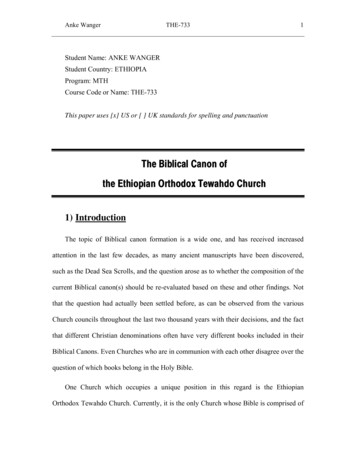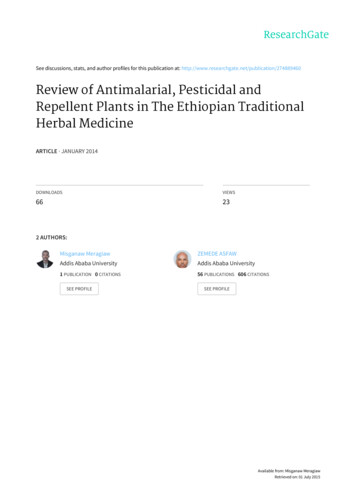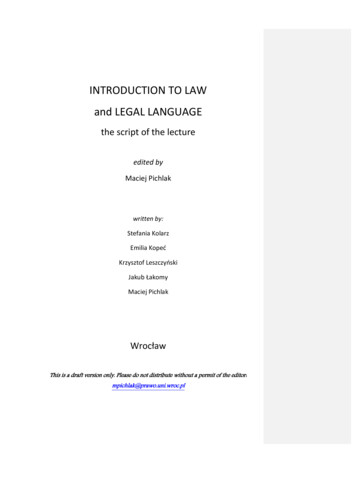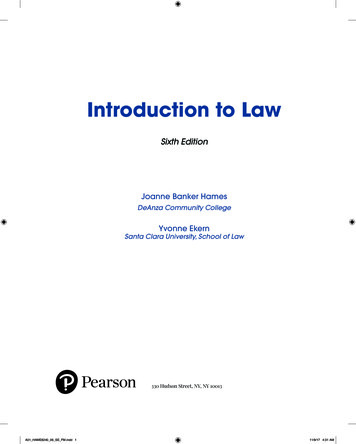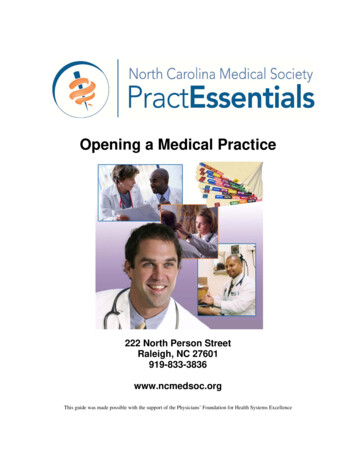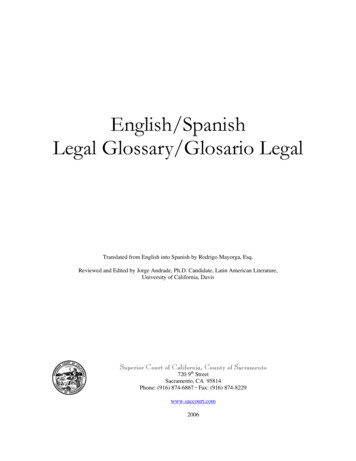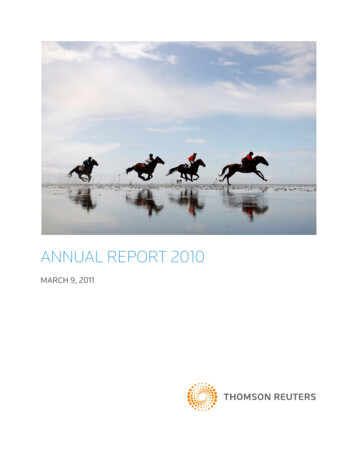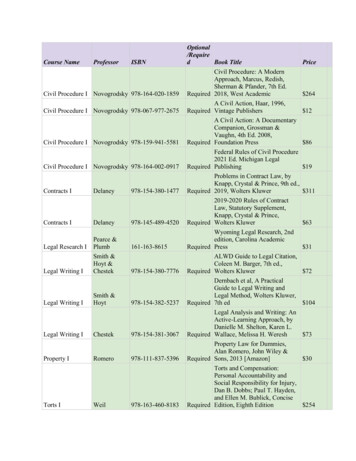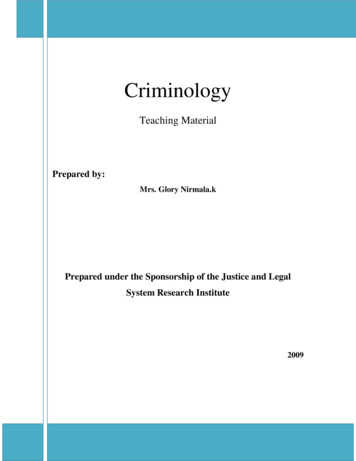
Transcription
CriminologyTeaching MaterialPrepared by:Mrs. Glory Nirmala.kPrepared under the Sponsorship of the Justice and LegalSystem Research Institute2009
TABLE OF CONTENTSUNIT I- SCOPE AND DEVELOPMENT OF CRIMINOLOGY .1Introduction 1Section.1. Understanding Criminology 31.1Defining Criminology .31.2Nature and Scope of Criminology .31.3Significance of Criminology .41.4Definitions Important Terms .81.5Inter-Relation between Criminology Penology and Criminal Law 91.6Criminology and Criminal Justice System .101.7Historical Development of Criminology .11Section 2- Early Explanations of Criminology-Schools of Thought 152.1 Pre-Classical School of Criminology .162.2 The Classical School 172.3 Neo-Classical School . 252.4 Positive School 272.5 Clinical School of Criminology .372.6 Sociological School of Criminology 382.7 The Modern Criminology 38Unit Summary .39References .42UNIT II- THEORIES OF CAUSATION OF CRIME 43Introduction .43Section 1-Biological Theories of Crime .441.1 Genetics and Criminality .451.2 Constitutional (Body Type) Determinants . 471.3. Constitutional Interactionist View . 49Section .2.Psychological Theories of Crime .512.1. Criminal Thinking Patterns .52i
2.2. Personality Defects .532.3. Psychoanalytic Explanations .53Section 3- Sociological Theories of Crime .573.1. Structural Explanations .573.2. Sub-Cultural Explanations .603.3. Multiple Factor Approach .643.4. Crimes in Urban and Rural Areas . 723.5 Neighborhood influences 73Section.4. Social-Psychological Theories of Crime .744.1. Control Theories .754.2. Learning Theories .78Unit Summary . 82References .84UNITIII- THE TYPOLOGIES AND MEASUREMENT OF CRIME . 85Introduction .85Section 1- The Typologies of Crime-A General Overview .85Section.2. Victimless-Crimes or Public Order Crimes 902.1. Definition and Nature .902.2. Justification and Limitation for Criminalizing Victimless Crimes 932.3. Decriminalization of Public Order Crimes .94Section 3- Juvenile Delinquency .1013.1. Definition .1013.2. Theoretical Perspectives on Juvenile Delinquency .1013.3. Juvenile Delinquency as a Male Phenomenon .1043.4. Risk factors .1053.5. Delinquency Prevention 107Section 4 White-Collar Crime .1074.1. Defining White Collar Crime 1084.2. Relationship to Other Types of Crime .1094.3. Principles of Liability and Defences .110ii
Section.5. Organized/Organizational Crime .1115.1 Definition and Scope .1115.2 Organized and International Crime .1135.3 Corporate Crime .1155.4 Political Crime . 122Section 6- Other Important Categories of Crime . 1236.1. Crimes against International Law .1236.2. Newest Crimes .126Section 7-Measurement of crime . 129Unit Summary 133References .135UNIT IV- VICTIMS, VICTIMIZATION AND VICTIMOLOGYAND RESTORATIVE JUSTICE .137Introduction 137Section1. Crime Victims 1381.1 Types of Victims 1381.2 Psychological Consequences affecting Crime victims .1391.3 Reluctance of Victims to Report Crimes .139Section.2. Victimization .1412.1. Definition and Nature .1412.2. Theories of Victim Blaming .1422.3. Victimization and Its Effects . 143Section.3. Victimology .1493.1. Definition and Scope .1493.2. Victimology and Its Variants 150Section 4- Restorative Justice .1544.1. Definition of Restorative Justice .1544.2. Historical Foundations of Restorative Justice .1554.3. Three principles form the foundation for restorative justice .156iii
4.4. Applications of Restorative Justice .1564.5. Programs to Attain Restorative Justice .1584.6. Key Values Restorative Programs 163Unit Summary 163References .165UNITV- CORRECTIONAL ADMINISTRATION ANDTREATMENT OF CRIMINALS .166Introduction . 166Section 1-Correctional Administration 1681.1 Institutional Treatment of offenders 1711.2 Treatment of Young Offenders 188Section 2- Punishment .1962.1. Meaning and Definition .1962.2. Essential Elements of ‘Punishment’ .1972.3. Philosophies of Punishment .1972.4. Objectives of Different Types of Punishment .2032.6 Rehabilitate or punish: How Should Society Treat Criminals?. 21Section 3- Alternatives to Imprisonment .2193.1. Parole System 2203.2. Probation .2223.3. Community-Based Rehabilitation .226Section 5- Essentials of an Ideal Penal System .240Unit Summary 244Case Comments .245References .247ANNEXURE .249iv
UNIT-ISCOPE AND DEVELOPMENT OF CRIMINOLOGYIntroduction:The word ‗Criminology‘ originated in 1890. The general meaning of the term is ―thescientific study of crime as a social phenomenon, of criminals and of penal institutions‖.Prof. Kenny (analyzed /defined/ described) that ‗Criminology is a branch of criminalscience which deals with crime causation, analysis and prevention of crime‖.Criminology as a branch of knowledge is concerned with those particular conducts ofhuman behaviour which are prohibited by society. It is, therefore, a socio-legal studywhich seeks to discover the causes of criminality and suggests the remedies to reducecrimes. Therefore, it flows that criminology and criminal policy are interdependent andmutually support one another. Thus criminology seeks to study the phenomenon ofcriminality in its entirety.The problem of crime control essentially involves the need for a study of the forcesoperating behind the incidence of crime and a variety of co-related factors influencing thepersonality of the offender. This has eventually led to development of moderncriminology during the preceding two centuries. The purpose of study of this branch ofknowledge is to analyze different aspects of crime and device effective measures fortreatment of criminals to bring about their re-socialization and rehabilitation in thecommunity. Thus criminology as a branch of knowledge has a practical utility in so far asit aims at bringing about the welfare of the community as a whole.The principles of criminology serve as effective guidelines for formulation of penalpolicy. The modern clinical methods and the reformatory measures such as probation,parole, indeterminate sentence, open prisons, and other correctional institutions areessentially an outcome of intensive criminological researches during the twentiethcentury. These measures have sufficiently demonstrated the futility of dumping offendersinside the prisons and infliction of barbaric punishments.Prof. Gillin has rightlyobserved that it is not the humanity within the criminal but the criminality within thehuman being which needs to be curbed through effective administration of criminal1
justice.More recently, criminologists and penologists seem to have agreed that―individualization of the offender should be the ultimate object of punishment, whiletreatment methods, the means to attain this end‖.The study of crime and criminal must proceed on a scientific basis by carefully analyzingvarious aspects associated therewith and must necessarily suggest measures proposed tosuppress criminality. It must be added that with new crimes emerging in the moderncomplexities of life, we seem increasingly concerned about the problem of crime. Todaydestructive acts of vandalism, highway, train and bank robberies, looting, bomb blasts,rape, illegitimate terrorist activities, white-collar crimes, cyber crimes, criminalization ofpolitics, hijacking, etc., are constantly increasing which have posed a positive danger tohuman life, liberty and property. Modern criminologists, therefore, seem to be seriouslyconcerned with the problem of crime to protect the society from such anti-social activitiesof criminals. It is for this reason that the two sister branches of criminal science, namely,criminology and penology work hand in hand to appreciate the problem of criminality inits proper perspective.Objectives:The purpose of this unit is to make the students understand the concepts of crime andschools of thought about explanation of criminal behaviour. The unit defines criminologyand other important terms necessary to appreciate the subject. The discussions under thissection also include a brief outline of the historical development of the branch ofcriminology, its purpose and scope.By the end of this unit, students will be able to: explain the meaning of criminology and define its nature and scope. distinguish the fields of criminology, penology, criminal law and their interrelationship; have a basic understanding of the historical development and the branchs ofcriminology;2
describe the major and school of thought about the criminal behaviour.Section. 1. Understanding Criminology1.1.Defining CriminologyCriminology maybe defined as “the scientific study of the causation, correction, andprevention of crime”. Criminology (from Latin crīmen, "accusation"; and Greek -λογία,-logia) is the social science approach to the study of crime as an individual and socialphenomenon. Although contemporary definitions vary in the exact words used, there isconsiderable consensus that criminology involves the application of the ―scientificmethod‖ to the study of variation in criminal law, the causes of crime, and reactions tocrime (Akers 2000).Criminological research areas include the incidence and forms of crime as well as itscauses and consequences. They also include social and governmental regulations andreactions to crime. Criminology is an interdisciplinary field in the behavioral sciences,drawing especially on the research of sociologists and psychologists, as well as onwritings in law. An important way to analyze data is to look at quantitative methods incriminology. In 1885, Italian law professor Raffaele Garofalo coined the term"criminology" (in Italian, criminologia). The French anthropologist Paul Topinard used itfor the first time in French (criminologie) around the same time.1.2.Nature and Scope of CriminologyCriminology is an inter-disciplinary field of study, involving scholars and practitionersrepresenting a wide range of behavioral and social sciences as well as numerous naturalsciences. Sociologists played a major role in defining and developing the field of studyand criminology emerged as an academic discipline housed in sociology programs.However, with the establishment of schools of criminology and the proliferation ofacademic departments and programs concentrating specifically on crime and justice inthe last half of the 20 century, the criminology emerged as a distinct professional fieldwith a broad, interdisciplinary focus and a shared commitment to generating knowledgethrough systematic research.3
One ultimate goal of criminology has been the development of theories expressed withsufficient precision that they can be tested, using data collected in a manner that allowsverification and replication.As a subdivision of the larger field of sociology, criminology draws on psychology,economics, anthropology, psychiatry, biology, statistics, and other disciplines to explainthe causes and prevention of criminal behavior. Subdivisions of criminology includepenology, the study of prisons and prison systems; bio-criminology, the study of thebiological basis of criminal behavior; feminist criminology, the study of women andcrime; and criminalistics, the study of crime detection, which is related to the field ofForensic Science. Much research related to criminology has focused on the biologicalbasis of criminal behavior. In fact, bio-criminology, attempts to explore the biologicalbasis of criminal behavior. Research in this area has focused on chromosomalabnormalities, hormonal and brain chemical imbalances, diet, neurological conditions,drugs, and alcohol as variables that contribute to criminal behavior.Criminology has historically played a reforming role in relation to Criminal Law and thecriminal justice system. As an applied discipline, it has produced findings that haveinfluenced legislators, judges, prosecutors, lawyers, Probation officers, and prisonofficials, prompting them to better understand crime and criminals and to develop betterand more human sentences and treatments for criminal behavior.Criminologists also study a host of other issues related to crime and the law. Theseinclude studies of the Victims of Crime, focusing upon their relations to the criminal, andtheir role as potential causal agents in crime; juvenile delinquency and its correction; andthe media and their relation to crime, including the influence of Pornography.1.3.Significance of CriminologyThe true effect of criminology upon practices in the criminal justice system is still subjectto question. Although a number of commentators have noted that studies in criminology4
have led to significant changes among criminal laws in the various states, other criticshave suggested that studies in criminology have not directly led to a reduction of crime.In Mc Cleskey v. Kemp, 481 U.S. 279, 107 S. Ct. 1756, 95 L. Ed. 2d 262 (1987), anindividual who had been sentenced to death for a murder in Georgia demonstrated to theU.S. Supreme Court that a criminologist's study showed that the race of individuals inthat state impacted whether the defendant was sentenced to life or to death. The studydemonstrated that a black defendant who had killed a white victim was four times morelikely to be sentenced to death than was a defendant who had killed a black victim. Thedefendant claimed that the study demonstrated that the state of Georgia had violated hisrights under theEQUAL PROTECTION CLAUSEof the Fourteenth Amendment, as well asunder the Eigth Amendment's protection against Cruel and Unusual Punishment.The high court disagreed. Although the majority did question the validity of the findings,of study's it held that the study did not establish that officials in Georgia had acted withdiscriminatory purpose, and that it did not establish that racial bias had affected theofficials' decisions with respect to the death sentence. Accordingly, the death sentenceviolated neither the Fourteenth Amendment nor the Eighth Amendment.Criminology has had more of an effect when states and the federal government considernew criminal laws and sentencing provisions. Criminologists' theories are also oftendebated in the context of the death penalty and crime control acts among legislators andpolicymakers. In this light, criminology is perhaps not at the forefront of the developmentof the criminal justice system, but it most certainly works in the background in thedetermination of criminal justice policies. Sociology and Criminology uring the twentieth century, the sociologicalapproach to criminology became the most influential approach. Sociology is thestudy of social behavior, systems, and structures. In relation to criminology, itmay be divided into social-structural and social-process approaches. Social-Structural Criminology Social-structural approaches to criminology examine theway in which social situations and structures influence or relate to criminal behavior. An5
early example of this approach, the ecological school of criminology, was developed inthe 1920s and 1930s at the University of Chicago. It seeks to explain crime's relationshipto social and environmental change. For example, it attempts to describe why certainareas of a city will have a tendency to attract crime and also have less-vigorous policeenforcement. Researchers have found that urban areas in transition from residential tobusiness uses are most often targeted by criminals. Such communities often havedisorganized social networks that foster a weaker sense of social standards.Another social-structural approach is the conflict school of criminology. It traces its rootsto Marxist theories that saw crime as ultimately a product of conflict between differentclasses under the system of capitalism. Criminology conflict theory suggests that the lawsof society emerge out of conflict rather than out of consensus. It holds that laws are madeby the group that is in power, to control those who are not in power. Conflict theoristspropose, as do other theorists, that those who commit crimes are not fundamentallydifferent from the rest of the population. They call the idea that society may be clearlydivided into criminals and non-criminals a dualistic fallacy, or a misguided notion. Thesetheorists maintain, instead, that the determination of whether someone is a criminal or notoften depends on the way society reacts to those who deviate from accepted norms. Manyconflict theorists and others argue that minorities and poor people are more quicklylabeled as criminals than are members of the majority and wealthy individuals.Critical criminology, also called radical criminology, shares with conflict criminology adebt to Marxism. It came into prominence in the early 1970s and attempted to explaincontemporary social upheavals. Critical criminology relies on economic explanations ofbehavior and argues that economic and social inequalities cause criminal behavior. Itfocuses less on the study of individual criminals, and advances the belief that existingcrime cannot be eliminated within the capitalist system. It also asserts, like the conflictschool, that law has an inherent bias in favor of the upper or ruling class, and that thestate and its legal system exist to advance the interests of the ruling class. Criticalcriminologists argue that corporate, political, and environmental crime are underreportedand inadequately addressed in the current criminal justice system.6
Feminist criminology emphasizes the subordinate position of women in society.According to feminist criminologists, women remain in a position of inferiority that hasnot been fully rectified by changes in the law during the late twentieth century. Feministcriminology also explores the ways in which women's criminal behavior is related to theirobjectification as commodities in the sex industry.Others using the social-structural approach have studied Gangs, juvenile delinquency,and the relationship between family structure and criminal behavior. Social-Process Criminology Social-process criminology theories attempt toexplain how people become criminals. These theories developed throughrecognition of the fact that not all people who are exposed to the same socialstructural conditions become criminals. They focus on criminal behavior aslearned behavior.Edwin H. Sutherland (1883–1950), a U.S. sociologist and criminologist who firstpresented his ideas in the 1920s and 1930s, advanced the theory of differentialassociation to explain criminal behavior. He emphasized that criminal behavior is learnedin interaction with others, usually in small groups, and that criminals learn to favorcriminal behavior over noncriminal behavior through association with both forms ofbehavior in different degrees. As Sutherland wrote, "When persons become criminal,they do so because of contacts with criminal patterns and also because of isolation fromanti-criminal patterns." Although his theory has been greatly influential, Sutherlandhimself admitted that it did not satisfactorily explain all criminal behavior. Later theoristshave modified his approach in an attempt to correct its shortcomings. Political CriminologyPolitical criminology is similar to the other camps in thisarea. It involves study into the forces that determine how, why, and with whatconsequences societies chose to address criminals and crime in general. Thosewho are involved with political criminology focus on the causes of crime, thenature of crime, the social and political meanings that attach to crime, and crimecontrol policies, including the study of the bases upon which crime and7
punishment is committed and the choices made by the principals in criminaljustice.Although the theories of political criminology and conflict criminology overlap to someextent, political criminologists deny that the terms are interchangeable. The primaryfocus points in the new movement of political criminology similarly overlap with othertheories, including the concerns and ramifications of street crime and the distribution ofpower in crime-control strategies. This movement has largely been a loose, academiceffort.1.4.Definitions of Important TermsDeviance: Deviance is a violation of social norms defining appropriate or proper behaviourunder particular set of circumstances. Deviance often includes criminal acts. Deviance is alsoreferred to as deviant behaviour. It is behavior that is sharply different from a customary,traditional, or generally accepted standard.Delinquency: Delinquent means one who fails to do that which is required by law or by dutywhen such failure is minor in nature. A delinquent is often used to refer to a juvenile whocommits a minor criminal act—juvenile delinquents.Juvenile Delinquency: It refers to criminal acts performed by juveniles. Most legal systemsprescribe specific procedures for dealing with juveniles, such as juvenile detention centers.Juvenile delinquency may refer to either violent or non-violent crime committed by personswho are (usually) under the age of eighteen and are still considered to be a minor. There ismuch debate about whether or not such a child should be held criminally responsible for hisor her own actions.Crime: Crime is an ‗act‘ or ‗omission‘ which is prohibited by criminal law. Each Statesets out a limited series of acts (crimes) which are prohibited and punishes thecommission of these acts by fine, imprisonment or some other form of punishment. Inexceptional cases, an omission to act can constitute a crime, such as failing to giveassistance to a person in peril or failing to report a case of child abuse.8
1.5.Inter-Relation Between Criminology, Penology and Criminal LawIt must be reiterated that criminology is one of the branches of criminal science which isconcerned with social study of crimes and criminal behavior. It aims at discovering thecauses of criminality and effective measures to combat crimes. It also deals with custody,treatment, prevention and control of crimes which, for the purposes of this study, istermed as penology. The criminal policies postulated by these twin sister branches (i.e.,criminology and penology) are implemented through the agency of criminal law. Thusfor the sake of convenient study the entire subject may be classified under the followingheads:It is generally said that criminal law is an index of civilization because it is sensitive tothe changes in social structure and reflects mental fiber of a given society. This is whyProf. Friedman calls it a barometer of moral thinking. According to Wechsler, ―crime is aformal social condemnation of forbidden conduct buttressed by sanction calculated toprevent it‖. Criminologists are thus confronted with three major problems, namely:1. What conducts should be forbidden and an inquiry into the effect ofenvironment on these conducts ;2. What condemnation is appropriate in such cases ; and9
3. What kinds of sanctions are best to prevent these conducts?It is thus evident that criminology, penology and criminal law are inter-related and onecannot really function without the other. The formulation of criminal policy essentiallydepends on crime causation and factors correlated therewith while its implementation isachieved through the instrumentality of criminal law. It has been rightly observed byProf. Sellin that the object of criminology is to study the sequence of law-making, lawbreaking and reaction to law-breaking from the point of view of the efficacy of law as themethod of control. According to Donald Taft, criminology is the scientific analysis andobservation of crime and criminals whereas penology is concerned with the punishmentand treatment of offenders. In his view, the development of criminology has been muchlater than that of penology because in early periods the emphasis was on treatment ofoffenders rather than scientific investigation into the causation of crime.1.6.Criminology and Criminal Justice SystemThe term ‗Criminal Justice System‘ is relatively new. It became popular only in 1967,with the publication of the report of the President‘s Commission on Law Enforcementand Administration of Justice, The Challenge of Crime in the Free Society. The discoverythat various ways of dealing with law breaking form a system was itself the result ofcriminological research. Research into the functioning of the system and its componentparts, as well as into the work of functionaries within the system, has provided manyinsights over the last few decades.Scientists who study the criminal justice system are frequently referred to as ‗criminaljustice specialists.‘ This term suggests a separation between criminology and criminaljustice. In fact, the two fields are closely interwoven. Scholars of both disciplines use thesame scientific research methods. They have received the same rigorous education, andthey pursue the same goals. Both fields rely on the cooperation of many other disciplines,including sociology, psychology, political science, law, economics, management, andeducation. Their origins, however, do differ. Criminology has its roots in European10
scholarship, though it has undergone refinements, largely under the influence ofAmerican sociology. Criminal justice is a recent American innovation.The two fields are also distinguished by a difference in focus. Criminology generallyfocuses on scientific studies of crime and criminality, whereas criminal justice focuses onscientific studies of decision-making processes, operations, and such justice-relatedconcerns as the efficiency of police, courts, and corrective systems; the just treatment ofoffenders; the needs of victims; and the effects of changes in sentencing philosophy.1.7.Historical Development of CriminologyThe history of primitive societies and early medieval period reveals that human thinking inthose days was predominated by religious mysticism and all human relations wereregulated through myths, superstitious and religious tenets prevailing in a particularsociety. This in other words, meant that little attention was devoted to the motive,environment and psychology of the offender in the causation of crime. Moreover, inabsence of any definite principle for the guidance of those who were concerned with thecriminal justice administration, punishments were often haphazard, arbitrary andirrational. This situation prevailed until the end of seventeenth century. Thereafter, withthe change in human thinking and evolution of modern society, certain social reformerstook up the cause of criminals and devoted their attention to analysis of crime causation.This finally led to the emergence of criminology as a branch of knowledge throughdevelopment of different schools of criminology.The theoretical dimension of criminology has a long history and ideas about the causes ofcrime can be found in philosophical thought over two thousand years ago. For example, inPolitics, Plato‘s student, Aristotle (384-322 B.C.), stated that ―poverty engenders rebellionand crime (Quinney 1970).‖ Religious scholars focused on causes as diverse as naturalhuman need, deadly sins, and the corrupting influence of Satan and other demons. Thevalidity of such theories was founded in religious authority and they were not viewed astheories, subject to verification through any form of systematic observation, measurementand analysis.11
Rational, naturalistic philosophies about people and society grew in prominence duringthe 18 century. Enlightenment philosophers such as Montesquieu, Voltaire, CesareBeccaria and Jeremy Bentham criticized political and legal institutions and advocatedsocial reforms based on the assumption that people were rational, deliberative beings.Such ideas constituted the first major school of organized, ―naturalistic‖ thought aboutcriminal law, criminality, and appropriate responses to crime--the Classical School. Suchperspectives were ca
Criminology is an interdisciplinary field in the behavioral sciences, drawing especially on the research of sociologists and psychologists, as well as on writings in law. An important way to analyze data is to look at quantitative methods in criminology. In 1885
